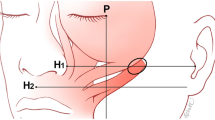Abstract
The pterygomandibular raphe (PMR) is a tendinous bundle between the bucinator (BM) and the superior constrictor of pharynx (SC) and has been considered essential for swallowing. Despite its functional significance, previous studies reported that the PMR is not always present. Another study reported presence of the connecting fascia between the BM and deep temporalis tendon (dTT). Therefore, the present study analyzed the three-dimensional relationship between the BM, SC, and dTT. We examined 13 halves of 11 heads from adult Japanese and Caucasian cadavers: eight halves macroscopically and five halves histologically. There was no clear border between the BM and SC in any specimens macroscopically. The BM attachment varied depending on its levels. At the level of the superior part of the internal oblique line, the BM fused with the SC with no clear border. At the level of the midpart of the internal oblique line of the mandible, the BM attached to the dTT directly, and the SC attached to the dTT via collagen fibers and the BM. Based on these results, these muscles should be described as the BM/dTT/SC (BTS) complex. The three-dimensional relationship of the BTS complex might result in the so-called “pterygomandibular raphe.“ The BTS complex could be important as a muscle coordination center in chewing and swallowing.




Similar content being viewed by others
Data Availability
Data sharing not applicable to this article as no datasets were generated or analyzed during the current study.
References
Dodds WJ, Stewart ET, Logemann JA. Physiology and radiology of the normal oral and pharyngeal phases of swallowing. AJR Am J Roentgenol. 1990;154(5):953–63.
Logemann JA. Evaluation and treatment of swallowing disorders. Austin Texas: ProEd; 1998.
Mioche L, Hiiemae KM, Palmer JB. A postero-anterior videofluorographic study of the intra-oral management of food in man. Arch Oral Biol. 2002;47(4):267–80.
Simon H. Face and scalp. In: Standring S, editor. Gray’s anatomy: the anatomical basis of clinical practice. 41st ed. Amsterdam: Elsevier; 2015. p. 495.
Griffin WL. Symptomatic ossification of the pterygomandibular raphe. Arch Otolaryngol. 1978;104:298–9. https://doi.org/10.1001/archotol.1978.00790050064016.
Shimada K, Gasser RF. Morphology of the Pterygomandibular Raphe in Human fetuses and adults. Anat Rec. 1989;224:117–22. https://doi.org/10.1002/ar.1092240115.
Tsumori N, Abe S, Agematsu H, et al. Morphologic characteristics of the superior pharyngeal constrictor muscle in relation to the function during swallowing. Dysphagia. 2007;22:122–9. https://doi.org/10.1007/s00455-006-9063-2.
Okada R, Muro S, Eguchi K, et al. The extended bundle of the Tensor Veli Palatini: anatomic consideration of the dilating mechanism of the eustachian tube. Auris Nasus Larynx. 2018;45(2):265–72. https://doi.org/10.1016/j.anl.2017.05.014.
Hur MS. Anatomical connections between the buccinator and the tendons of the temporalis. Annals of Anatomy. 2017;214:63–6. https://doi.org/10.1016/j.aanat.2017.08.005.
Plank J, Rychlo A. [A method for quick decalcification]. Zentralbl Allg Pathol. 1952;89:252–4.
Bassettand K, et al. Local Anesthesia for Dental Professionals. 2nd ed. London: Pearson; 2014.
Iwanaga J, Singh V, Ohtsuka A, et al. Acknowledging the use of human cadaveric tissues in research papers: recommendations from anatomical journal editors. Clin Anat. 2021;34(1):2–4.
Acknowledgements
The authors sincerely thank those who donated their bodies to science so that anatomical research could be performed. Results from such research can potentially increase mankind’s overall knowledge that can then improve patient care. Therefore, these donors and their families deserve our highest gratitude [12].
Author information
Authors and Affiliations
Contributions
All authors contributed to the study’s conception and design. Material preparation, data collection, and analyses were performed by KF, MI, and JI. The first draft of the manuscript was written by KF, and all authors commented on subsequent versions. All authors have read and approved the final manuscript.
Corresponding author
Ethics declarations
Conflict of interest
The authors declare that they have no conflict of interest.
Additional information
Publisher’s Note
Springer Nature remains neutral with regard to jurisdictional claims in published maps and institutional affiliations.
Rights and permissions
Springer Nature or its licensor (e.g. a society or other partner) holds exclusive rights to this article under a publishing agreement with the author(s) or other rightsholder(s); author self-archiving of the accepted manuscript version of this article is solely governed by the terms of such publishing agreement and applicable law.
About this article
Cite this article
Fukino, K., Iitsuka, M., Kitagawa, N. et al. Three-dimensional Analysis of the Muscles Related to the So-Called “Pterygomandibular Raphe”: An Anatomical and Histological Study. Dysphagia (2024). https://doi.org/10.1007/s00455-023-10645-3
Received:
Accepted:
Published:
DOI: https://doi.org/10.1007/s00455-023-10645-3




